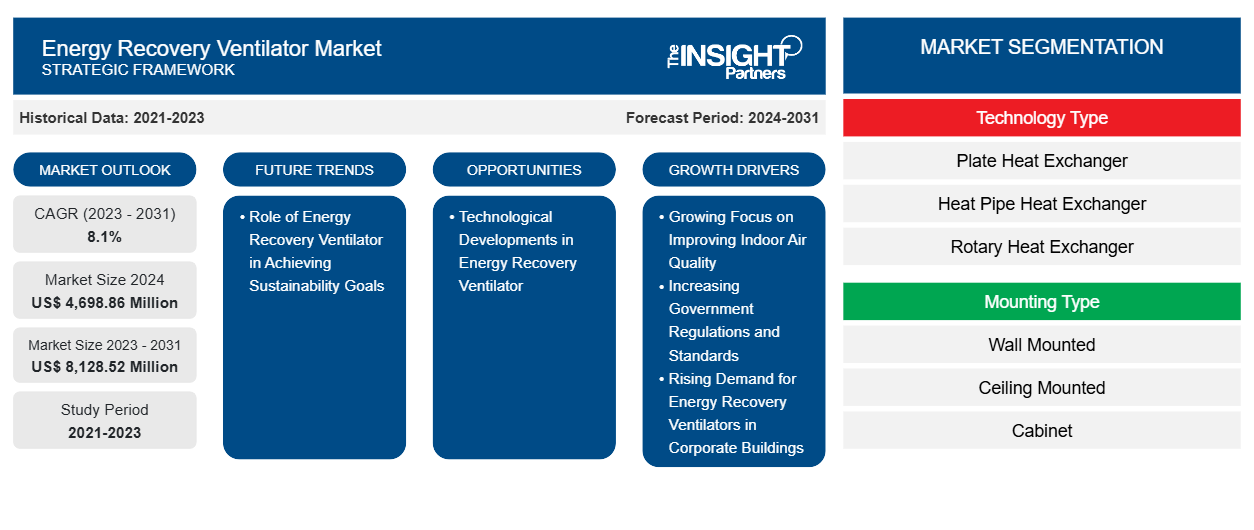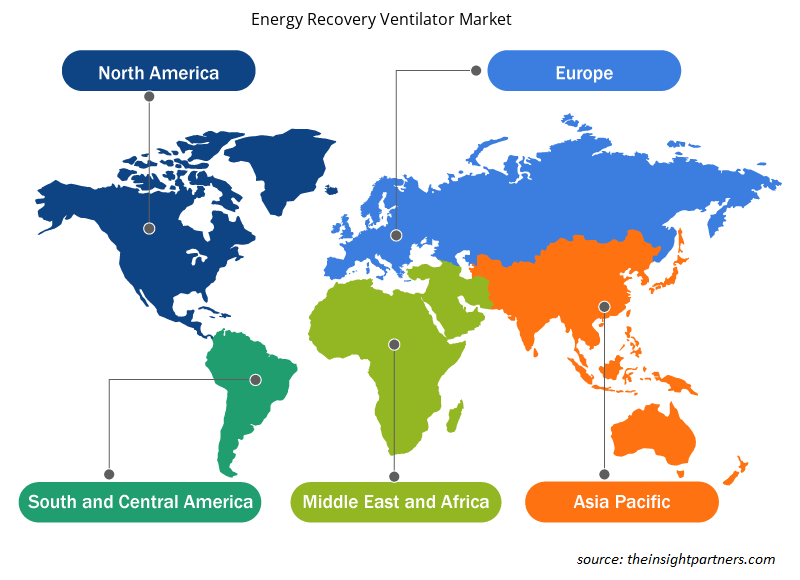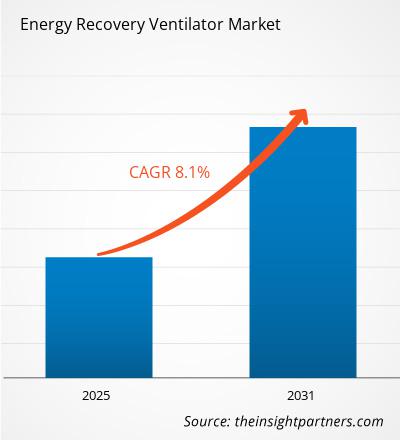Der Markt für Energierückgewinnungsventilatoren wird voraussichtlich von 4.698,86 Millionen US-Dollar im Jahr 2024 auf 8.128,52 Millionen US-Dollar im Jahr 2031 anwachsen. Für den Zeitraum 2025–2031 wird eine durchschnittliche jährliche Wachstumsrate (CAGR) von 8,1 % erwartet. Das weltweit wachsende Nachhaltigkeitsbewusstsein dürfte in den kommenden Jahren neue wichtige Markttrends mit sich bringen.
Marktanalyse für Beatmungsgeräte mit Energierückgewinnung
Die Menschen in Amerika verbringen rund 90 % ihrer Zeit in Innenräumen. Daher ist die richtige Lüftungsstrategie entscheidend für ein sicheres und gesundes Raumklima. Da Gebäude immer luftdichter, kompakter und energieeffizienter werden, bleiben Schadstoffe in der Raumluft zurück, was zu einer schlechten Raumluftqualität ( IAQ ) führt. Typische Schadstoffe sind flüchtige organische Verbindungen (VOC), die beim Kochen, Putzen, Polstern, Möbeln und Malerarbeiten freigesetzt werden, sowie Feuchtigkeit beim Duschen, Kochen und Atmen. Zu den negativen Auswirkungen schlechter Luftqualität oder unzureichender Belüftung zählen gesundheitliche Probleme, die Verbreitung von durch die Luft übertragenen Krankheiten und geringere Produktivität. Daher wird das zunehmende Bewusstsein für eine gute Luftqualität in Wohn-, Gewerbe- und Industriegebieten den Markt für energierückgewinnende Lüftungsgeräte zwischen 2025 und 2031 voraussichtlich ankurbeln.
Das Bewusstsein für die Verbesserung der Raumluftqualität wächst, unterstützt durch staatliche Vorschriften und Standards. Zudem steigt die Nachfrage nach Energierückgewinnungslüftern in Firmengebäuden und treibt das Marktwachstum an. Die Komplexität der Installation und der häufige Wartungsaufwand dürften das Wachstum des Marktes für Energierückgewinnungslüfter jedoch hemmen. Darüber hinaus werden technologische Entwicklungen im Bereich der Energierückgewinnungslüfter in den kommenden Jahren voraussichtlich Chancen für Unternehmen auf diesem Markt schaffen. Darüber hinaus wird erwartet, dass die Rolle von Energierückgewinnungslüftern bei der Erreichung von Nachhaltigkeitszielen zwischen 2025 und 2031 der wichtigste Zukunftstrend im Markt für Energierückgewinnungslüfter sein wird.
Marktübersicht für Beatmungsgeräte mit Energierückgewinnung
Lüftung trägt dazu bei, die Übertragung von durch die Luft übertragenen Krankheiten in Innenräumen zu reduzieren . Ein Energierückgewinnungsventilator ( ERV ) ist ein passives Energierückgewinnungsgerät, das den Energieverbrauch von Heizungs-, Lüftungs- und Klimaanlagen minimiert. Er bereitet die Lüftungsluft vor, indem er Energie aus der Gebäudeabluft überträgt. Daher interagieren Lüftungs- und Abluftströme im ERV direkt oder indirekt zur Energieübertragung. Zu den wichtigsten Endnutzern von Energierückgewinnungsventilatoren, die weltweit zum Marktwachstum beitragen, zählen Wohn- und Geschäftsgebäude sowie Branchen wie Energie- und Versorgungsunternehmen, Rechenzentren, Einzelhandel, Gastgewerbe und Industrieanlagen (über die Fertigung hinaus). Die Nachfrage nach effizienten, maßgeschneiderten HLK- Systemen für verschiedene Branchen steigt, wie z. B. die Leiterplattenherstellung, den Bergbau, die Lebensmittel- und Getränkeindustrie, die Pharmaindustrie und Reinraumsysteme . Viele Industrie- und Produktionsgebäude weisen hohe Emissionswerte auf. Produktionsprozesse erfordern die regelmäßige Abfuhr von überschüssiger Wärme oder Schadstoffen aus der Raumluft über ein lokales oder allgemeines Abluftsystem. Daher setzen Produktionsstätten verstärkt auf den Einsatz von Energierückgewinnungsventilatoren, um Lüftungs- und Energiestandards einzuhalten, die Raumluftqualität zu verbessern und die Gesamtkapazität der HLK- Anlage zu minimieren. Darüber hinaus erfordert die Erholung der Wertschöpfung im verarbeitenden Gewerbe auf globaler Ebene erhebliche Kapitalinvestitionen.
Passen Sie diesen Bericht Ihren Anforderungen an
Sie erhalten kostenlos Anpassungen an jedem Bericht, einschließlich Teilen dieses Berichts oder einer Analyse auf Länderebene, eines Excel-Datenpakets sowie tolle Angebote und Rabatte für Start-ups und Universitäten
Markt für Beatmungsgeräte mit Energierückgewinnung: Strategische Einblicke

-
Informieren Sie sich über die wichtigsten Markttrends in diesem Bericht.Dieses KOSTENLOSE Beispiel umfasst Datenanalysen, von Markttrends bis hin zu Schätzungen und Prognosen.
Markttreiber und Chancen für Beatmungsgeräte mit Energierückgewinnung
Wachsender Fokus auf die Verbesserung der Luftqualität in Innenräumen
Die Luftqualität in Innenräumen hat großen Einfluss auf Wohlbefinden und Gesundheit, egal ob zu Hause oder am Arbeitsplatz. Unzureichende Belüftung kann einen Raum stickig und ungemütlich machen. Die Belastung durch Schadstoffe wie Radon, Schimmel, Pressholzprodukte (die Formaldehyd enthalten können), Passivrauchen und andere Materialien kann zu gesundheitlichen Problemen wie Lungenkrebs und Asthma führen. Eine schlechte Luftqualität in Innenräumen (IAQ) wirkt sich negativ auf die kognitiven Funktionen, die Gesundheit und das Wohlbefinden der Bewohner aus. Die Environmental Protection Agency (EPA) gibt an, dass die Produktivität am Arbeitsplatz um 5–6 % gesteigert werden kann, wenn die Luftqualität als gut eingestuft wird. Eine ausgewogene und erhöhte Belüftung optimiert die Luftqualität in Innenräumen mithilfe eines Energierückgewinnungsventilators.
Technologische Entwicklungen bei Beatmungsgeräten mit Energierückgewinnung
Da die Anwendungsmöglichkeiten für Energierückgewinnungsventilatoren in verschiedenen Sektoren zunehmen, konzentrieren sich die Marktteilnehmer stark auf die Entwicklung neuer Produkte sowie die Verbesserung ihrer bestehenden Produktlinien, um den Bedürfnissen ihrer Kunden gerecht zu werden. So brachte die Panasonic Corporation im Februar 2024 den Energierückgewinnungsventilator WhisperComfort 60 auf den Markt. Dieser neue Energierückgewinnungsventilator ist vom Home Ventilating Institute (HVI) zertifiziert und bietet Kunden eine bessere, energieeffiziente und kostengünstige Wohnraumlüftung. Darüber hinaus hat sich die Panasonic Corporation mit ARISTA Homes (Hausbauer in Nordamerika) zusammengetan, um Privathaushalte mit WhisperAir RepairR-Spot-Luftreinigern oder dem Energierückgewinnungsventilator Intelli-Balance auszustatten. Darüber hinaus stellte LG Electronics (LG) im Juli 2020 eine erweiterte Produktlinie von Puricare-Luftpflegelösungen vor. Die neuen Lösungen bieten dringend benötigte Linderung bei schlechter Raumluftqualität, die durch Industrieverschmutzung oder lokale Wetterphänomene wie Sandstürme und Staub verursacht wird.
Segmentierungsanalyse des Marktberichts für Energierückgewinnungsventilatoren
Wichtige Segmente, die zur Ableitung der Marktanalyse für Beatmungsgeräte mit Energierückgewinnung beigetragen haben, sind Technologietyp, Montagetyp und Endbenutzer.
- Basierend auf dem Technologietyp wird der globale Markt für Energierückgewinnungsventilatoren in Plattenwärmetauscher, Wärmerohrwärmetauscher, Rotationswärmetauscher, Kreislaufwärmetauscher und andere unterteilt. Das Segment Plattenwärmetauscher dominierte 2024 den Marktanteil der Energierückgewinnungsventilatoren.
- Basierend auf der Montageart ist der globale Markt für Energierückgewinnungslüfter in Wandmontage, Deckenmontage und Schrankmontage unterteilt. Wandmontierte Energierückgewinnungslüfter verzeichneten im Jahr 2024 den größten Marktanteil auf dem Markt für Energierückgewinnungslüfter.
- Basierend auf den Endverbrauchern ist der Markt für Energierückgewinnungsventilatoren in Wohn-, Gewerbe- und Industriebereiche unterteilt. Das gewerbliche Segment war im Jahr 2024 Marktführer.
Energierückgewinnungsventilatoren Marktanteilsanalyse
Der Marktbericht für Energierückgewinnungsventilatoren bietet eine detaillierte globale Analyse der geografischen Lage. Nordamerika, Europa und der asiatisch-pazifische Raum zählen zu den wichtigsten Regionen mit deutlichem Wachstum im Markt für Energierückgewinnungsventilatoren.
Nordamerika dominierte den Markt für Beatmungsgeräte mit Energierückgewinnung im Jahr 2024. Europa leistet den zweitgrößten Beitrag zum globalen Markt für Beatmungsgeräte mit Energierückgewinnung, gefolgt vom asiatisch-pazifischen Raum. Nordamerika erlebt ein enormes Marktwachstum aufgrund der Präsenz wichtiger Akteure, die sich auf die Weiterentwicklung und Einführung von Beatmungsgeräten mit Energierückgewinnung in verschiedenen Branchen und im Immobiliensektor konzentrieren. Darüber hinaus treibt die Präsenz der wichtigsten Fertigungswirtschaften, darunter die USA, Kanada und Mexiko, die Nachfrage nach Beatmungsgeräten mit Energierückgewinnung an. Die USA sind nach China die zweitgrößte Produktionsnation. Auf sie entfielen im Jahr 2023 etwa 16 % der gesamten Fertigungsleistung der Welt. Darüber hinaus tragen Kanada und Mexiko mit steigenden Investitionen in den Aufbau von Produktionsstandorten zum Wachstum des Marktes für Beatmungsgeräte mit Energierückgewinnung in Nordamerika bei. Darüber hinaus treibt der starke Fokus auf Forschung und Entwicklung, Automatisierung und Digitalisierung die Nachfrage nach Beatmungslösungen in den USA an.
Europa hält einen bedeutenden Anteil am Markt für Energierückgewinnungsventilatoren. Die Region ist bekannt für ihre etablierten Produktionsstätten, unter anderem in der Automobil-, Luft- und Raumfahrt-, Maschinenbau- und Bauindustrie. Diese Branchen sind in hohem Maße energieabhängig und benötigen daher Lüftungssysteme, um hohe Präzision und Effizienz in Betrieb und Produktion zu erreichen. Deutschland ist ein wichtiger Markt innerhalb Europas und bekannt für seine technologisch fortschrittlichen Ingenieur- und Fertigungskapazitäten. Darüber hinaus wächst der Wohn- und Gewerbeimmobiliensektor in der Region rasant.
China dominiert den Markt für Energierückgewinnungsventilatoren im asiatisch-pazifischen Raum. Das Wachstum der Fertigungsindustrien wie Automobil, Luft- und Raumfahrt, Verteidigung sowie des Wohn- und Gewerbesektors treibt die Nachfrage nach Energierückgewinnungsventilatoren in der Region an. Diese Branchen benötigen in ihren Produktionsabläufen HLK-Systeme und Kältemaschinen, was zu einem höheren Energieverbrauch und erhöhten Kohlendioxidemissionen führt. Auch der Nahe Osten, Afrika und Südamerika trugen zum Wachstum des Marktes für Energierückgewinnungsventilatoren bei, da dort Investitionen in die Industrialisierung, die zunehmende Urbanisierung, Investitionen in kommerzielle Projekte und die Ausweitung der Produktionsstandorte in den Regionen stiegen.
Regionale Einblicke in den Markt für Beatmungsgeräte mit Energierückgewinnung
Die Analysten von Insight Partners haben die regionalen Trends und Faktoren, die den Markt für Energierückgewinnungsventilatoren im Prognosezeitraum beeinflussen, ausführlich erläutert. In diesem Abschnitt werden auch die Marktsegmente und die geografische Lage von Energierückgewinnungsventilatoren in Nordamerika, Europa, Asien-Pazifik, dem Nahen Osten und Afrika sowie Süd- und Mittelamerika erläutert.

- Erhalten Sie regionale Daten zum Markt für Beatmungsgeräte mit Energierückgewinnung
Umfang des Marktberichts über Beatmungsgeräte mit Energierückgewinnung
| Berichtsattribut | Details |
|---|---|
| Marktgröße im Jahr 2024 | 4.698,86 Millionen US-Dollar |
| Marktgröße bis 2031 | 8.128,52 Millionen US-Dollar |
| Globale CAGR (2025 – 2031) | 8,1 % |
| Historische Daten | 2021-2023 |
| Prognosezeitraum | 2024–2031 |
| Abgedeckte Segmente |
Nach Technologietyp
|
| Abgedeckte Regionen und Länder |
Nordamerika
|
| Marktführer und wichtige Unternehmensprofile |
|
Marktteilnehmerdichte für Energierückgewinnungsventilatoren: Verständnis ihrer Auswirkungen auf die Geschäftsdynamik
Der Markt für Beatmungsgeräte mit Energierückgewinnung wächst rasant. Die steigende Nachfrage der Endverbraucher ist auf Faktoren wie veränderte Verbraucherpräferenzen, technologische Fortschritte und ein stärkeres Bewusstsein für die Produktvorteile zurückzuführen. Mit der steigenden Nachfrage erweitern Unternehmen ihr Angebot, entwickeln Innovationen, um den Bedürfnissen der Verbraucher gerecht zu werden, und nutzen neue Trends, was das Marktwachstum weiter ankurbelt.
Die Marktteilnehmerdichte beschreibt die Verteilung der in einem bestimmten Markt oder einer bestimmten Branche tätigen Unternehmen. Sie gibt an, wie viele Wettbewerber (Marktteilnehmer) in einem bestimmten Marktraum im Verhältnis zu dessen Größe oder Gesamtmarktwert präsent sind.
Die wichtigsten Unternehmen auf dem Markt für Beatmungsgeräte mit Energierückgewinnung sind:
- Daikin Industries Ltd
- Greenheck Fan Corp
- Munters Group AB
- Nortek Air Solutions, LLC
- Fujitsu General Ltd
- LG Electronics Inc.
Haftungsausschluss : Die oben aufgeführten Unternehmen sind nicht in einer bestimmten Reihenfolge aufgeführt.

- Überblick über die wichtigsten Akteure auf dem Markt für Beatmungsgeräte mit Energierückgewinnung
Marktnachrichten und aktuelle Entwicklungen zum Energierückgewinnungsventilator
Der Markt für Energierückgewinnungsventilatoren wird durch die Erhebung qualitativer und quantitativer Daten aus Primär- und Sekundärforschung bewertet, die wichtige Unternehmenspublikationen, Verbandsdaten und Datenbanken umfasst. Nachfolgend sind einige Entwicklungen im Markt für Energierückgewinnungsventilatoren aufgeführt:
- Panasonic, ein führender Anbieter von Lüftungs- und Wohnraumlösungen für die Baubranche, hat die Markteinführung seiner Energierückgewinnungsventilatoren (ERV) der Serien BalancedHome Elite und Elite Plus bekannt gegeben. Die neuen ERVs der BalancedHome-Serie sind vielseitig und effizient und bieten Bauherren die Flexibilität, zwischen acht verschiedenen Modellen mit vier verschiedenen CFM-Stufen zu wählen. (Quelle: Panasonic Corporation, Pressemitteilung, Dezember 2024)
- Daikin Saudi Arabia (Daikin Industries Ltd) hat ein neues Werk in Saudi-Arabien eröffnet. Dort sollen Lüftungsgeräte und andere angewandte Klimalösungen hergestellt werden. Durch diese Expansion stärkte das Unternehmen seine Position auf dem Markt für Energierückgewinnungsventilatoren im Nahen Osten und in Afrika. (Quelle: Daikin Industries Ltd, Pressemitteilung, November 2020)
Marktbericht zu Beatmungsgeräten mit Energierückgewinnung – Umfang und Ergebnisse
Der Bericht „Marktgröße und Prognose für Energierückgewinnungsventilatoren (2021–2031)“ bietet eine detaillierte Analyse des Marktes, die die folgenden Bereiche abdeckt:
- Marktgröße und Prognose für Energierückgewinnungsventilatoren auf Länderebene für alle wichtigen Marktsegmente, die im Rahmen des Geltungsbereichs abgedeckt sind
- Markttrends für Beatmungsgeräte mit Energierückgewinnung sowie Marktdynamiken wie Treiber, Einschränkungen und wichtige Chancen
- Detaillierte PEST- und SWOT-Analyse
- Marktanalyse für Energierückgewinnungsventilatoren mit Blick auf wichtige Markttrends, Länderrahmen, wichtige Akteure, Vorschriften und aktuelle Marktentwicklungen
- Branchenlandschafts- und Wettbewerbsanalyse mit Marktkonzentration, Heatmap-Analyse, prominenten Akteuren und jüngsten Entwicklungen für den Markt für Energierückgewinnungsventilatoren
- Detaillierte Firmenprofile
- Historische Analyse (2 Jahre), Basisjahr, Prognose (7 Jahre) mit CAGR
- PEST- und SWOT-Analyse
- Marktgröße Wert/Volumen – Global, Regional, Land
- Branchen- und Wettbewerbslandschaft
- Excel-Datensatz
Aktuelle Berichte
Erfahrungsberichte
Grund zum Kauf
- Fundierte Entscheidungsfindung
- Marktdynamik verstehen
- Wettbewerbsanalyse
- Kundeneinblicke
- Marktprognosen
- Risikominimierung
- Strategische Planung
- Investitionsbegründung
- Identifizierung neuer Märkte
- Verbesserung von Marketingstrategien
- Steigerung der Betriebseffizienz
- Anpassung an regulatorische Trends






















 Kostenlose Probe anfordern für - Markt für Beatmungsgeräte mit Energierückgewinnung
Kostenlose Probe anfordern für - Markt für Beatmungsgeräte mit Energierückgewinnung